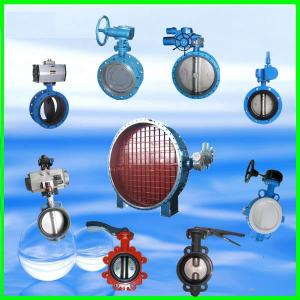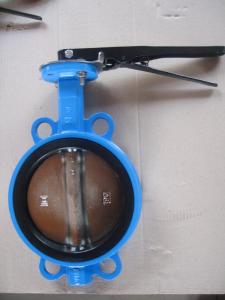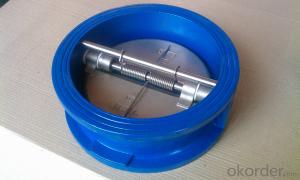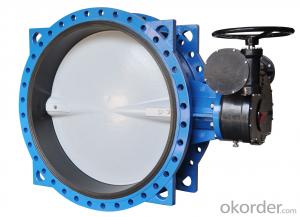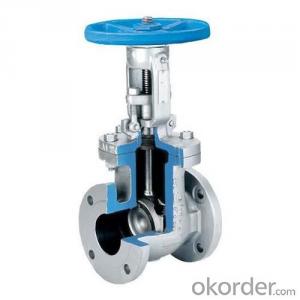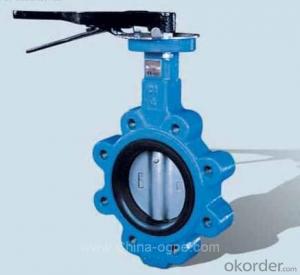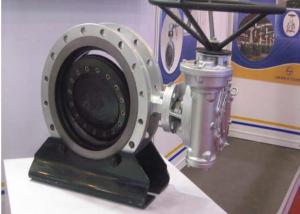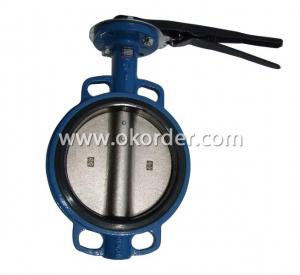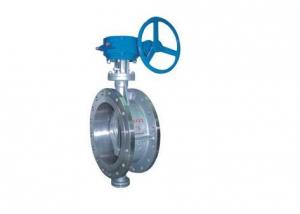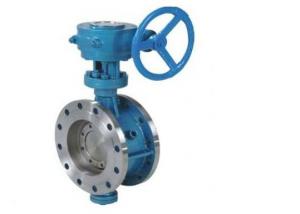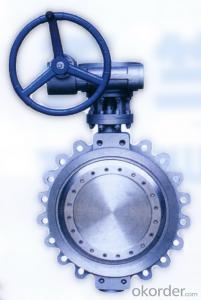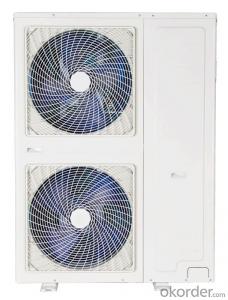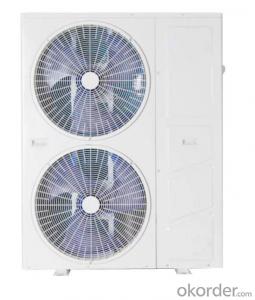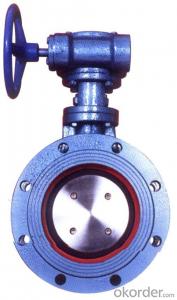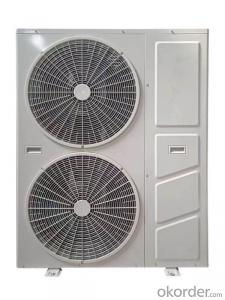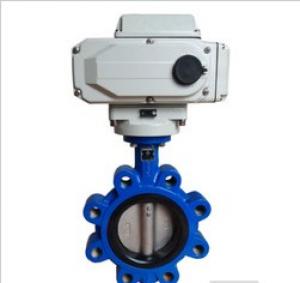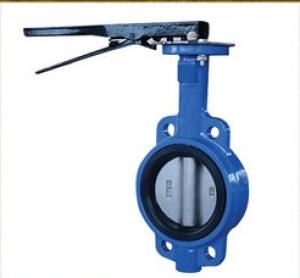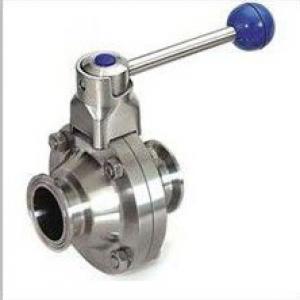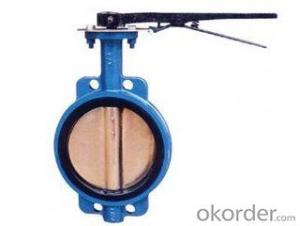Butterfly Valves Ductile Iron Wafer Type DN680
- Loading Port:
- China main port
- Payment Terms:
- TT OR LC
- Min Order Qty:
- 100 set
- Supply Capability:
- 80000 set/month
OKorder Service Pledge
OKorder Financial Service
You Might Also Like
1. Manual Wafer Butterfly Valve Description:
A butterfly valve consists of body ,stem ,disc , actuator (manual actuator, worm-gear actuator , aerodynamic actuator or electric actuator) , and wafer type butterfly valve can implement the process for turning on turning off and regulating the flow by the circumrotation of stem and disc that is droved by actuators.
2.Main Features of the Manual Wafer Butterfly Valve
1.Simple and compact construction. Small in size and light in weight. Easy transportation, installation and maintenance.
2. Quick 90 degrees on-off operation. Minimized operating torque ,energy saving.
3. Excellent sealing performance with no leakage. Long service life.
4. Wide selection of materials ,applicable for various media..
5. Flow curve tending to straight line. Excellent regulation performance.
Design & Manufacture acc. to API 609,MSS SP-67,BS5155,BS EN593.
Face to Face acc. to DIN3202,API609,MSS SP-67,BS5155,BS EN558.
Top Flange acc. to ISO5211.
Pressure test acc. to API598,BS EN12266-1,DIN3230,BS5155.
Side Flange acc. to DIN2501,ANSI125/150,AS2129,BS4504,BS10D&E,JIS10K
3. Manual Wafer Butterfly Valve Images:

4.Manual Wafer Butterfly Valve Specification:
Size: | DN50-DN1000 |
End flange: | ANSI B 16.1,EN1092,AS2129 |
Face to face: | ANSI B 16.10 |
Top flange: | ISO 5211 |
Normal pressure: | PN1.0/1.6MPa(150/200PSI) |
Body: | CI/DI/WCB/ALB/CF8/CF8M |
Disc: | DI/ALB/Rubber lined Disc/1.2501/1.4529/CF8/Hastelloy Alloy/Monel |
Stem: | 410/416/304/431/17-4PH/316/monel |
Seat: | NBR/Hypalon/EPDM/Neoprene/NR/Wear-Resistant EPDM/Viton/Silicon/Heat-Resistant EPDM/White EPDM/EPDM(NSF)/PTFE |
Suitable temperature: | -10~120 |
Medium: | Fresh water, sewage, sea water, air, vapor, food, medicine, oils, alkalis, salt etc. |
| Packaging Detail: | Inner packing: Individual polybag for each valve Outer packing: plywood box~veneer case, standard size is 1150*950*550mm/1150*950*600mm We can also make the case according to consumer's requirement or the real size of valves. |
5.FAQ
1. What is manual wafer butterfly valve?
A: Wafer style is the more common of the two and is less expensive than the lug style. The wafer style butterfly valve is just about the standard. It ís so common that no one even bothers to use the word "wafer" when ordering a butterfly valve. It is taken for granted that if a butterfly valve is ordered, a wafer style will be received.
2. How about the Installation of the Wafer Style Butterfly Valve?
A: Butterfly valves are installed by inserting the valve between two flanges using bolts or studs and nuts to hold it all together. This type of installation, of course, makes it impossible to disconnect just one side of the piping system from the valve. That benefit is received using the lug style valve.
3. What is the working principle of manual wafer butterfly valve?
A: A butterfly valve is from a family of valves called quarter-turn valves. In operation, the valve is fully open or closed when the disc is rotated a quarter turn. The "butterfly" is a metal disc mounted on a rod. When the valve is closed, the disc is turned so that it completely blocks off the passageway. When the valve is fully open, the disc is rotated a quarter turn so that it allows an almost unrestricted passage of the fluid. The valve may also be opened incrementally to throttle flow.
| Packaging Detail: | Inner packing: Individual polybag for each valve Outer packing: plywood box~veneer case, standard size is 1150*950*550mm/1150*950*600mm We can also make the case according to consumer's requirement or the real size of valves. |
- Q:Butterfly valve structure and working principle
- How it works: the disc is driven by the stem, and if it turns 90 degrees, it can be opened and closed once. By changing the deflection angle of the plate, the flow of the medium can be controlled. There are two kinds of butterfly valves commonly used: clip type butterfly valve and flanged butterfly valve.
- Q:How can the flange butterfly valve be installed on the pipe?
- Direction.Butterfly valve in theory can be installed in any direction, it is recommended that the horizontal installation of the valve shaft installation, so that both ends of the bearings will not be at the bottom (below), so as to avoid sediment in the media into the bearing.Inlet pipe configuration.There are water inlet side valve elbow, tee pipe fluid caused by bending and uneven distribution of the inflow valve, the drift will occur in the pipe, so it must be generated by the uniform drift disposed on both sides of the disc, so as to avoid uneven force on both sides of the disc, and may produce additional torque.
- Q:What's the difference between butterfly valves and check valves?
- Butterfly valve is manual, only switch function.The check valve is an automatic valve, which prevents backflow of the pipe medium.
- Q:1988 volkswagon cabriolet, rabbit tried mystery oil let sit for a week having trouble with stuck valves even taken a wrenrch to manually unstick. help any suggestions 4 cyclinder car has been sitting up for about 4 years
- The only reason for a stuck valve is if it bent from a thrown timing belt. Sitting 4 years will not cause valves to stick usually, because there is always some oil leakage from the head, that prevents rust. How do you know the valve is stuck? Have you done a compression test, checked the valve clearance? When you say you take a wrench to manually unstick it, it would help to know what you mean, because there is no place to put a wrench that would help unstick a valve that was stuck. You need to tell us much more.
- Q:Butterfly valve in use when should pay attention to what problems?
- In the process of using the butterfly valve, you should timely notice valve state, without excessive loosening, no abnormal leakage, or abnormal high temperature and so on, if there is abnormal, should immediately close the valve, to identify the reasons for the problem, treatment after use, it is also very important.
- Q:Are fire fighting signal valves and signal butterfly valves the same thing?
- The same nature: both can open and close, there is also information back fed.Signal valves are collectively referred to as signal butterfly valves.
- Q:Have an iron block, aluminum heads, solid roller lifters, Jessel rocker shafts, what should my valve clearances be cold, and hot??
- Well, generally it's going to be .030 intake and exhaust (hot). Adjust to those clearances cold then recheck at operating temp. But it would really help to know year, make, cu. in., which aftermarket heads, to be absolutely sure. On some engines it is .024 intake / .030 exhaust and so on, depends on the lifters and valve train geometry.. What brand of lifters and cam profile? Usually they will specify valve lash and adjusting procedures. Edit: Wow, kinda' tight valve lash, krazybob, ( might be a lttle tough on the old cam lobes), and then there is your timing numbers / advice with absolutely no details to base it on ( H.E.I.?..which brand? / mechanical advance curve?, and vacuum advance numbers?, cam timing, brand of lifters, cam specs, rocker arm ratio)...Look, S-51D, the best idea is to Do- It- Right using the correct adjustment specs. The data is out there, once the configuration is identified.
- Q:What do you mean, handle, butterfly valve, hard back and soft back?
- Hello, soft sealing butterfly valve is generally divided into skeleton, seat and frameless valve seat, the skeleton of the general material: resin, aluminum, iron.. Etc.. With back seat is on the back of the vulcanized rubber, without skeleton, valve seat is rubber.
- Q:What's the difference between D71X-16 and D71H-16 butterfly valves?
- Model D71X model means this, D represents butterfly valve, 7 represents butterfly connection form for clip type connection, 1 represents straight through, and 16 represents pressure 16 kg pressure.X stands for sealing and soft sealing, and the sealing surface is usually nbr.H stands for metal hard sealing, usually 2Cr13 surfacing.D71X-16 butterfly valve featuresIts main features are:1 、 the design is novel, reasonable, unique structure, light weight, fast opening and closing.2 、 small operating torque, easy operation, labor-saving and smart.3. It can be installed and maintained conveniently in any position.4, seals can be replaced, sealing performance is reliable, to achieve two-way sealing, zero leakage.5, sealing materials aging resistance, corrosion resistance, long service life and so on.
- Q:What's the difference between a clip on handle butterfly valve and a turbo butterfly valve? Where are they used?
- Just drive differently,Handle butterfly valve is generally small caliber, because generally small caliber torque smaller, can be directly opened and closed by handTurbine butterfly gear box drive stem rotation.The selection principle for when the stem torque is greater than 300N.M when used in gear box drive gear box, and use the handwheel control hand wheel force is not greater than 300 nm.
1. Manufacturer Overview |
|
|---|---|
| Location | |
| Year Established | |
| Annual Output Value | |
| Main Markets | |
| Company Certifications | |
2. Manufacturer Certificates |
|
|---|---|
| a) Certification Name | |
| Range | |
| Reference | |
| Validity Period | |
3. Manufacturer Capability |
|
|---|---|
| a)Trade Capacity | |
| Nearest Port | |
| Export Percentage | |
| No.of Employees in Trade Department | |
| Language Spoken: | |
| b)Factory Information | |
| Factory Size: | |
| No. of Production Lines | |
| Contract Manufacturing | |
| Product Price Range | |
Send your message to us
Butterfly Valves Ductile Iron Wafer Type DN680
- Loading Port:
- China main port
- Payment Terms:
- TT OR LC
- Min Order Qty:
- 100 set
- Supply Capability:
- 80000 set/month
OKorder Service Pledge
OKorder Financial Service
Similar products
New products
Hot products
Hot Searches
Related keywords



